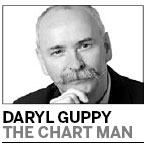 |
Large Medium Small |

When the Dow index moves below the 200 day moving average many people believe it points to a significant change in the market trend. It sounds an attractive idea but closer investigation shows it is not that useful. The Dow oscillated around the value of the 200-day moving average in 2007 and 2008. Its collapse started after the index moved below the 200 day moving average in 2008 January but the index moved above the 200 day average in 2008 April. In May 2008 it fell below the 200 day average again and stayed there until July 2009.
Between May 2010 and July the Dow has the same pattern as it oscillates around the 200 day moving average. It has given four sell signals and five buy signals in the last three months. One week we are bullish and the next week we are bearish. The problem is that this method of chart analysis does not provide any useful information about the trend in the market. Using an index move above or below the 200 day moving average is not a very useful method for finding significant changes in the trend.
We use a chart of price activity in four different ways. The first is as a record of the price paid for a stock. The graphic chart display makes it easy to compare today's price with prices paid in the past. Once we see 260 days of price behavior we also immediately observe certain patterns of price behavior. This includes clear uptrends, downtrends and sideways movements.
The second use is as a record of the emotions of a crowd of buyers and sellers. Their emotions change over time as they grow to like, or dislike, the stock. This emotional record appears on the price chart as trends. Uptrends show when the market falls in love with a stock. Downtrends tell us when the love affair has ended. These trends are easily seen on a price chart.
The third use is as an exact record of crowd behavior. We look for repeated chart patterns. These help identify high probability trading events such as a breakout rally from a triangle pattern. The current head and shoulder pattern development in the Dow is a record of crowd behavior.
The fourth use is for the statistical analysis of price activity. We take the price data and interpret the information to find the average of price movement, or volatility or momentum. A moving average line is a simple indicator that provides basic technical analysis or interpretation of price data.
Price trends are exciting because we can see the opportunity to make money if we buy stock at the bottom of a downtrend and sell it at the top of an uptrend. It is very easy to find these turning points on a chart of price history, but it is much more difficult to achieve in real time.
The objective in trend trading is to find a strong, established trend several days or weeks after it has started. Then we stay with the trend until the trend has proved that it has ended. The trend may last weeks or months. The price chart is a record of the emotions of the crowd and it charts their behavior and their support for the trend.
If traders follow the trend they need to know when to stop following it. A 200-day moving average line does not help make this decision effectively because it only shows the relationship between today's price and the average 200-day price. Many traders use a trend line to define when the trend has ended because this shows when the trending behavior of investors has changed.
The author is a well-known international financial technical analysis expert